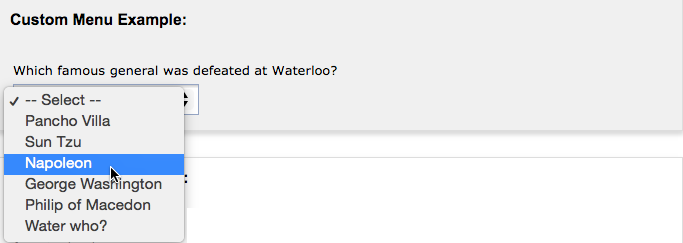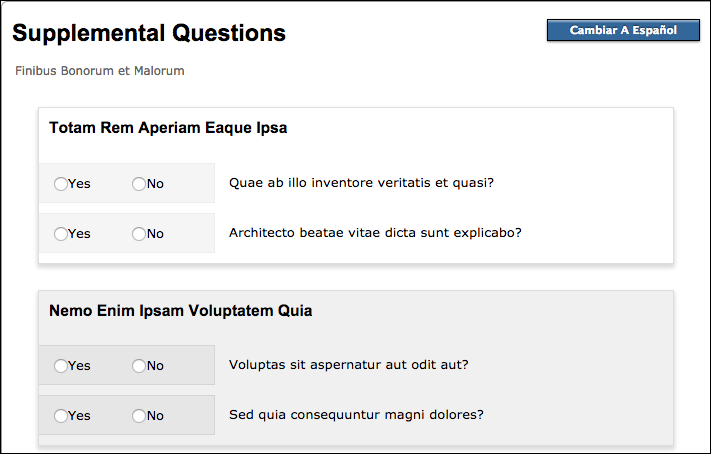Last Update: November 17, 2021
...
Supplemental questions are written in XML and validated with XSD. You can create one or more sets of supplemental questions to be added to either your college's CCCApply Standard Application and/or the Noncredit Application. Only one supplemental question set can be active/display at a time. The Configuring Application Supplemental Questions section of the CCCApply Administrator User Guide provides details on importing, updating, and downloading your Supplemental Question XML files.
...
Note: The Noncredit application is a workflow and subset of the CCCApply Standard applications questions that skips the residency check and military status for students who are only taking noncredit courses. See the Noncredit Application section of the CCCApply Standard & Noncredit Application Data Dictionary for more details.
...
Most of the contents of your XML file will depend on the questions you want to ask and the responses you expect to receive. For details on creating questions and guiding the student through the application process see Supplemental Questions: Layout And User Experience and Supplemental Questions: Response Elements.
Setting up Your XML File
Copy and paste the example starter XML file structure below into your XML editor before you begin creating questions. This text will serve as your XML base and you can use it over and over again for each new supplemental question XML file set.
?xml version ="1.0" encoding="UTF-8"?>
<SupplementalQuestions xmlns:xsi="http://xmlns.cccnext.org/apply" CollegeId="nnn" CollegeName="My College" ApplicationType="Either Credit or Noncredit">
</SupplementalQuestions>
2. Set CollegeId to your college's three-digit MIS code. If you are creating questions for multiple colleges in a district, then indicate the MIS codes of all of the applicable colleges, separated by commas.
...
<?xml version ="1.0" encoding="UTF-8"?>
<SupplementalQuestions xmlns:xsi="http://xmlns.cccnext.org/apply"
CollegeId="611" CollegeName="Allan Hancock College" ApplicationType="Noncredit">
<Header>Tell us more about yourself!</Header>
<Section>
<YesNo id="1">
<Label>While attending classes, do you intend to work more than 40 hours per week?</Label>
</YesNo>
</Section>
</SupplementalQuestions>
| Note |
|---|
Important: The example above is a complete and legal definition of a supplemental questions page. However, you will need to:
|
| Note |
|---|
Important: It is very important that your uploaded XML file be error-free. If there are errors in your supplemental questions XML file, you will likely see an error message in the Administrator when you attempt to upload it. |
It is strongly recommended that before uploading, you validate your XML with a free, online validator tool such as http://www.xmlvalidation.com/. This site allows you to copy and paste your XML for syntax checking.
...
Both <Label> and <HoverHelp> are used only as child elements of the response elements. The <Label> element can be thought of as the question being asked for a response element, while the <HoverHelp> element can be used to provide further explanatory text when the applicant clicks the Help icon next to the related input field. Multiple <HoverHelp> children are allowed, one for each language your student application supports. The optional <Translations> element allows you to specify English or Spanish language (internationalize) for your questions. You must include at least two <Locale> elements, one with a <lang> attribute of "es" and one without, as well as a message block.
...
This hover help from the example above will appear when the page is in English mode: <HoverHelp lang="en">Check this box if you enjoy watching sporting events</HoverHelp>
...
This hover help from the example above will appear when the page is in Spanish mode: <HoverHelp lang="es">Marque si te gusta ver los eventos deportivos</HoverHelp>
...
| Warning |
|---|
Warning: You must specify a language (using the lang attribute as in the examples above) for your hover help or your Supplemental Questions tab will fail and the applicant will see an error message rather than your supplemental questions. |
...
<Header>main.header</Header>
<Section>
<Header>section.1.header</Header>
...
<HoverHelp lang="es">Ingrese su nombre completo</HoverHelp>
</Text>
<Menu id="1">
<Label>question.color</Label>
...
<MenuItem value="3" label="question.color.3"/> <
</Menu>
</Section>
...each has a corresponding <Message code="" message=""/> in the <Translations> element's <Locale> element; the first in English and the second in Spanish:
<Translations>
<Locale>
<Message code="main.header" message="Here are some questions"/>
<Message code="section.1.header" message="Knowledge (en and es)"/>
<Message code="여행지 추천 설문지 | where to go " message="What is your name?"/>
<Message code="question.color" message="What is your favorite color?"/>
<Message code="question.color.1" message="Red"/>
<Message code="question.color.2" message="Blue"/>
<Message code="question.color.3" message="Yellow"/>
</Locale>
<Locale lang="es">
<Message code="main.header" message="Aquí hay algunas preguntas." />
<Message code="section.1.header" message="Conocimiento"/>
<Message code="여행지 추천 설문지 | where to go " message="¿Cuál es su nombre?"/>
<Message code="question.color" message="¿Cuál es su color favorito?" />
<Message code="question.color.1" message="Rojo" />
<Message code="question.color.2" message="Azul" />
<Message code="question.color.3" message="Amarillo" />
</Locale>
</Translations>
Response Element: The Default Attribute
Depending on your specific circumstances, you can allow the applicant to ignore a given question, or you can require the applicant to provide a response. If you allow a question to be ignored, the system will store a system-default value for the question. The legal default values depend on the response element you specified. When you add a default attribute to a response element, the system auto-answers the question with the default value you specify. When the page appears, the question displays as already answered:
<Section>
<Header>Examples with the "default" attribute:</Header>
<Checkbox id="29" default="checked"><Label>I would like to be contacted concerning financial aid.</Label></Checkbox>
<Text id="20" default="Mozart"><Label>Name a few of your favorite composers:</Label></Text>
</Section>
The following table shows the legal defaults for each response element.
Response Element | Element Legal Default |
|---|---|
Checkbox | "checked" or "unchecked" |
CountryList | Any of the two-character country codes in the Data Dictionary (Standard or International) Date See note below. |
Menu | The contents of the value attribute in any of the <MenuItem> elements you create for the menu. See The <Menu> Element for details. |
PhoneNumber | |
StatesList | Any of the two-character state codes in the Data Dictionary for the application (Standard or International). |
Text | Any free-form text less than the maximum length of 250 characters, or less than the maximum you set using the maxLength attribute. |
YesNo | "yes" or "no" |
Note: It is recommended that you do not set a default for a <Date> element, as it will malfunction on the student application page.
Note: Because a response is automatically filled in when you set a default, setting required"=
...
true” will have no effect. The applicant can simply ignore the question, in which case the default you have supplied will be stored in the database when the student submits the application.
Response Element: The required Attribute
The required attribute allows you to require that the applicant respond to selected response elements, or to groups of response elements. To require responses to all the elements in a section, use required"=tru"e in the <Section> element. For an example, see the discussion of the title attribute below. To require responses to an individual element, use required"=tru"e true” in that element.
The following is an example of a <CountryList> element that requires the applicant to select a country:
<CountryList id="3" required="true" title="Your country of birth">
<Label>Select the country in which you were born.</Label>
</CountryList>
...
The system will not allow the applicant to continue the application process if no country is selected. Instead, an error message will be displayed:
...
Note: The title attribute allows you to customize the error message somewhat, to make it easier for the applicant to understand the nature of the error. It is best to supply a title for every response node; see The title Attribute section above for details.
Note: For <Checkbox> elements, required"=tru"e means that the applicant must mark the check box. This applies to <Checkbox> elements within a <Section> that has required"=tru"e, as well as individual <Checkbox> elements that have required"=tru"e. This might be useful for requiring the applicant to read the application carefully or agree to some specific terms:
<Checkbox id="11" required="true" title="Your agreement to the contract">
...
<Label>I agree to the terms and conditions of the contract.</Label>
</Checkbox>
...
Response Element Attribute: The
...
title Attribute
The title attribute allows you to give names to response elements to make certain error messages more intelligible to the applicant. Consider the following example, in which the <Section> element contains required"=tru"e. This means all of the yes/no questions in the section must be answered.
<Section required="true">
<Header>While you attend classes, do you intend to...</Header>
<YesNo id="1"><Label>...work more than 40 hours per week?</Label></YesNo>
<YesNo <YesNo id="2"><Label>...enroll in a vocational education program (VEP)?</Label></YesNo>
<YesNo id="3"><Label>...care for children or elderly persons in your family?
</Label></YesNo>
<YesNo <YesNo id="4"><Label>...care for children or elderly persons outside your familyyour family?</Label></YesNo>
</Section>
The system will not allow the applicant to continue the application process if any of these questions are left unanswered. Instead, an error message will be displayed:
...
It is unlikely that the applicant will understand these errors. It is recommended that you always use the title attribute to make the error message friendlier wherever you require a response.
<Section required="true">
<Header>While <Header>While you attend classes, do you intend to...</Header>
<YesNo id="1" title="The question about your work schedule">
<Label> <Label>...work more than 40 hours per week?</Label>
< </YesNo>
<YesNo
<YesNo id="2" title="The question about your plans for enrolling in a VEP">
<Label> <Label>...enroll in a vocational education program (VEP)?</Label>
< </YesNo>
<YesNo id="3" title="The question about your family obligations">
<Label>...care for children or elderly persons in your family?</Label>
< </YesNo>
<YesNo id="4" title="The question about your non-family care obligations">
<Label> <Label>...care for children or elderly persons outside your family?</Label>
< </YesNo>
</Section>
...
Supplemental Questions: Response Elements
...
Response elements can contain both <Label> and <HoverHelp> child elements to help guide the user through the application process. Certain attributes such as default and required can also be assigned to response elements for guiding the user. See Supplemental Questions: Layout And User Experience for details.
Each type of response element is associated with a group of fields in the database. Responses to <Checkbox> elements, for example, are stored in a group of fields whose names follow the pattern of supp_check_ followed by a two-digit number. There are 50 supp_check fields in the database, from supp_check_01 to supp_check_50. The id attribute you assign to each response element will determine which particular field the response is stored in.
For example, the response to <Checkbox id="42"> will be stored in the field called supp_check_42. When you are ready to download student data to your college's Student Information System, you will use these field names to tell the Download Client which data you want.
The following table shows the association between a response element and the supplemental questions database.
...
</Section>
In the database (and Download Client results, if downloaded), the example answers in the image above would result in a "0" being stored in supp_check_01 and supp_check_04, while a "1" would be stored in supp_check_02 and supp_check_03.
...
In the database, a "1" would be stored into supp_yesno_01 if the applicant selected "Yes", or a "0" if the applicant selected.







